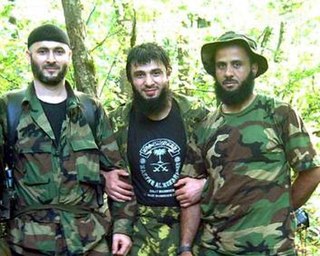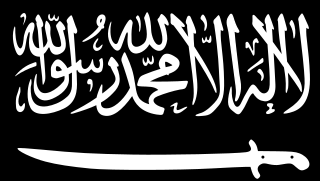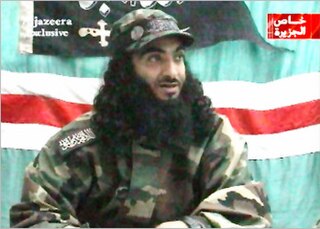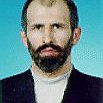Related Research Articles

The Second Chechen War took place in Chechnya and the border regions of the North Caucasus between the Russian Federation and the Chechen Republic of Ichkeria, from August 1999 to April 2009.

Shamil Salmanovich Basayev, also known by his kunya "Abu Idris", was a North Caucasian guerilla leader who served as a senior military commander in the breakaway Chechen Republic of Ichkeria. He held the rank of brigadier general in the Armed Forces of Ichkeria, and was posthumously declared generalissimo. As a military commander in the separatist armed forces of Chechnya, one of his most notable battles was the separatist recapture of Grozny in 1996, which he personally planned and commanded together with Aslan Maskhadov. He also masterminded several of the worst terrorist attacks that occurred in Russia.

Samir Saleh Abdullah Al Suwailim, more commonly known as Ibn al-Khattab or Emir Khattab, was a Saudi mujahid emir, well known for his participation in the First and Second Chechen Wars.

The Russian apartment bombings were a series of explosions that hit four apartment blocks in the Russian cities of Buynaksk, Moscow, and Volgodonsk in September 1999, killing more than 300, injuring more than 1,000, and spreading a wave of fear across the country. The bombings, together with the Invasion of Dagestan, triggered the Second Chechen War. The handling of the crisis by Vladimir Putin, who was prime minister at the time, boosted his popularity greatly and helped him attain the presidency within a few months.

Dagestan, officially the Republic of Dagestan, is a republic of Russia situated in the North Caucasus of Eastern Europe, along the Caspian Sea. It is located north of the Greater Caucasus, and is a part of the North Caucasian Federal District. The republic is the southernmost tip of Russia, sharing land borders with the countries of Azerbaijan and Georgia to the south and southwest, the Russian republics of Chechnya and Kalmykia to the west and north, and with Stavropol Krai to the northwest. Makhachkala is the republic's capital and largest city; other major cities are Derbent, Kizlyar, Izberbash, Kaspiysk, and Buynaksk.

Rasul Makasharipov, nicknamed Muslim and also known as Emir Rasul, was a Dagestani Islamist leader in southern Russia. He was the founder of the militant group Dzhennet and later created the rebel group Shariat Jamaat, which sought to unite Caucasian Muslims under Islamic rule and later became part of the Caucasian Front.
The 1999 war in Dagestan, also known as the Dagestan incursions, was an armed conflict that began when the Chechen-based Islamic International Peacekeeping Brigade (IIPB), an Islamist group led by Shamil Basayev, Ibn al-Khattab, Ramzan Akhmadov and Arbi Barayev, invaded the neighboring Russian republic of Dagestan on 7 August 1999, in support of the Shura of Dagestan separatist rebels. The war ended with a major victory for the Russian Federation and Republic of Dagestan and the retreat of the IIPB. The invasion of Dagestan served as the main casus belli alongside the series of apartment bombings in September 1999 for the Second Chechen War.

The Dagestan Autonomous Soviet Socialist Republic (1921–1991), abbreviated as Dagestan ASSR or DASSR and also unofficially known as Soviet Dagestan or just simply Dagestan, was an autonomous republic of the Russian SFSR within the Soviet Union. This "Land of Mountains" was known also for having a "mountain of peoples," with more than thirty ethnic groups indigenous to the territory. This region was absorbed in to the Russian empire in 1813 after the signing of the Gulistan Peace Treaty, and subsequently became a breeding ground for early revolutionary fervor in the Russian Revolution due its people's discontent with being part of the empire.
The Kizlyar–Pervomayskoye hostage crisis, also known in Russia as the terrorist act in Kizlyar, occurred in January 1996 during the First Chechen War. What began as a raid by Chechen separatist forces led by Salman Raduyev against a federal military airbase near Kizlyar, Dagestan, became a hostage crisis involving thousands of civilians, most of whom were quickly released. It culminated in a battle between the Chechens and Russian special forces in the village of Pervomayskoye, which was destroyed by Russian artillery fire. Although the Chechens escaped from the siege with some of their hostages, at least 26 hostages and more than 200 combatants on both sides died. One third of the homes in Pervomayskoye were destroyed.

Rappani Khalilov, also known as Rabbani, was the militant leader of the Shariat Jamaat of the Caucasian Front during the Second Chechen War, in the volatile southern Russian republic of Dagestan. He was killed on September 17, 2007, in a fierce shoot-out with the Russian special forces.

The 2000 Zhani-Vedeno ambush took place on March 29, 2000, when a mechanized column of Russian Interior Ministry troops was ambushed in the southern Vedensky District of Chechnya. As the result of the attack on the convoy and on Russian relief forces, scores of Russian special police and paramilitary troops were killed or captured. 37 OMON officers in the column and six in a relief column were killed and 11 more were taken hostage, 9 of whom were executed soon after Russian command refused to swap them for the arrested military officer Yuri Budanov.

Vilayat Dagestan, formerly known as Shariat Jamaat, was an Islamist Jihadist group based in the Russian republic of Dagestan and is part of the Caucasus Emirate. The group is closely associated with the separatist conflicts in the nearby Russian republics of Chechnya and Ingushetia, and was created during the Second Chechen War in favor of Dagestan's independence as an Islamic state.

Abu al-Walid was a Saudi Arabian of the Ghamd tribe who fought as a "mujahid" volunteer in Central Asia, the Balkans, and the North Caucasus. He was killed in April 2004 in Chechnya by the Russian federal forces.

The insurgency in the North Caucasus was a low-level armed conflict between Russia and militants associated with the Caucasus Emirate and, from June 2015, the Islamic State, in the North Caucasus. It followed the official end of the decade-long Second Chechen War on 16 April 2009. It attracted volunteers from the MENA region, Western Europe, and Central Asia. The Russian legislation considers the Second Chechen War and the insurgency described in this article as the same "counter-terrorist operations on the territory of the North Caucasus region".
Karamakhi is a rural locality in Buynaksky District of the Republic of Dagestan, Russia. Population: 4,537 (2010 Census); 3,647 (2002 Census).

The Islamic Djamaat of Dagestan, known in Russia as the Kadar zone, was an Islamist political entity in the Buynaksky District of Dagestan consisting of the fortified villages of Kadar, Karamakhi and Chabanmakhi. In the late 1990s, the Djamaat, heavily influenced by militant Wahhabism, declared independence and ejected Dagestani officials from the area. After a series of armed conflicts with Dagestani police and local moderate Muslims, the Djamaat broke off from government control. Sharia law was introduced in the villages, the Russian Constitution was declared void and an alliance was signed with Chechen forces with the aim of establishing an Independent Islamic Republic in the Caucasus.

Nadirshakh Mugadovich "Nadir" Khachilayev was a Russian politician, member of the 2nd State Duma, lower house of the Federal Assembly.
References
- ↑ Hunter, Sileen; Jeffrey L. Thomas; Alexander Melikishvili; J. Collins (2004). Islam in Russia: The Politics Of Identity and Security. M.E. Sharpe. ISBN 978-0-7656-1283-0.
- ↑ "Cookies not enabled?". 2 September 1999.
- 1 2 Dr Mark Smith, A Russian Chronology July 1999 - September 1999
- ↑ Взрыв жилого дома в Москве положил конец спокойствию в столице
- ↑ Russia caught in sect's web of terror
- ↑ "Autumn 1999 terrorist bombings have a murky history". Jamestown Foundation. February 7, 2002.
- ↑ ’’Islam in Russia’’ by Shireen Hunter, Jeffrey L. Thomas, Alexander Melikishvili, J. Collins. P.91
- ↑ "Russia: Dagestani official denies existence of Dagestan Liberation Army". Archived from the original on 2011-08-09. Retrieved 2009-02-14.
- 1 2 3 Reddaway, Peter; Dmitri Glinski (2001). The Tragedy of Russia's Reforms: Market Bolshevism Against Democracy. United States Institute of Peace Press. pp. 615–616. ISBN 1-929223-06-4.
- ↑ Murphy, Paul (2004). The Wolves of Islam: Russia and the Faces of Chechen Terror. Potomac Books Inc. p. 106. ISBN 978-1-57488-830-0.